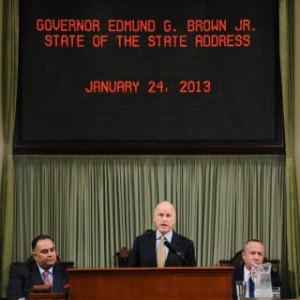“I would prefer to trust our teachers…”
Posted on | January 25, 2013 | Comments Off on “I would prefer to trust our teachers…”
California’s Back! Gov. Jerry Brown did himself proud in Thursday’s state-of-the-state speech, and he did California proud, too. In the details of the speech, there are prospects for boldness, greatness, and innovation, not the tire patching and gridlock we’ve experienced as government.
Others will comment in great length on the wisdom of the San Joaquin delta tunnel project and whether high-speed rail is prescient or folly. And educational interests are putting the pencil to whether they win or lose under the governor’s plan for simplifying public education funding and regulation. (See David Plank’s Los Angeles Times commentary.)
Instead of joining these conversations, or commenting on the literary illusions in the governor’s speech, please zoom in one sentence that has revolutionary importance: “I would prefer to trust our teachers who are in the classroom each day, doing the real work—lighting fires in young minds.”
Brown knows that we live in a world that profoundly distrusts teachers. Most of what passes for education reform has been crafted with the assumption that teachers are incompetent or malfeasant. Education systems, therefore, are layered with micromanagement rather than characterized by useful feedback mechanisms that make teachers smart about their work. It bends the mind to contemplate what a radical change would be required if public education were built around high-trust assumptions.
But there are places that trust teachers with substantive decisions and hard-nosed accountability. I’ve written about some of them, including the Avalon School in St. Paul, and in a new book Trusting Teachers with School Success, Kim Farris-Berg and Edward Dirkswager describe practices that build high commitment and performance in schools where teachers:
- Select their colleagues.
- Evaluate them, transferring or terminating them if necessary.
- Set the staffing pattern, including the allocation of personnel to teaching and other duties.
- Select leaders.
- Determine the budget.
- Determine salaries and benefits.
- Choose and build the instructional program.
- Set schedules including school day and year.
- Set school policies including those for homework and discipline.
Teachers in real schools—some district schools, some charters—work with all or most of these powers. These schools are essentially producer cooperatives. Most don’t have a principal, but this doesn’t mean that there is no leadership. There is often a designated teacher leader, and other roles are designated or exercised in common. Authority vests in a professional community rather than a hierarchy.
Along with the shift in authority comes inevitable responsibility, and in the schools I visited teachers coached and evaluated one another, and teachers who couldn’t teach were asked to leave. Teachers balanced the school’s budgets, including cutting their own salaries when times were tough. They built and rebuilt the curriculum to make it responsive to student wishes. And when, as sometimes happens, their bright ideas didn’t work they closed down their schools.
While Gov. Brown’s school finance plan will help move money to districts with fewer restrictions, it won’t go very far toward creating the kinds of jobs that Farris-Berg and Dirkswager write about.
There need to be policies that establish legally protected zones of professional practice, and there are several policies the governor might consider:
- Amend statutes creating an easy way for school districts to create autonomous, charter-like schools within their own schools. Boston and Los Angeles have already done this with Pilot Schools, and the San Francisco Community School operates within the conventional public school district.
- Amend charter law allowing special purpose authorizers that would assist the formation of teacher-run charter schools and review the quality of their proposals. Minnesota passed such a law with wide bipartisan support. It has spawned the Minnesota Guild of Public Charter Schools, founded by the Minneapolis Federation of Teachers, Local 59, with the goal of authorizing high quality teacher-run schools. It’s launch was supported by a grant from the American Federation of Teachers Innovation Fund. The first application for a school is pending state approval.
- Amend the state’s collective bargaining statute to make an agreement about student achievement goals a mandatory subject of contracts with teacher unions. This would require discussions about money and work rules take place in the context of ideas for improving student outcomes. While not necessarily leading to the kinds of autonomy/responsibility that takes place in the teacher-run schools, it would push the reset button on the context of labor relations.
All these ideas are radical: much more radical than a high-speed train or a tube under the delta.
But in his speech, the governor decried “The laws that are in fashion demand tightly constrained curricula and reams of accountability data. All the better if it requires quiz-bits of information, regurgitated at regular intervals and stored in vast computers. Performance metrics, of course, are invoked like talismans. Distant authorities crack the whip, demanding quantitative measures and a stark, single number to encapsulate the precise achievement level of every child.”
This vision won’t materialize without intervention from the top. If the governor wants to build a different world of teaching and learning than that being pushed by U.S. Secretary Arne Duncan (commentary HERE), then California will have to construct and pull some new policy levers.
Tags: Edward Dirkswager > Jerry Brown > Kim Farris-Berg > Teacher Run Schools





